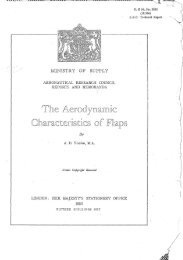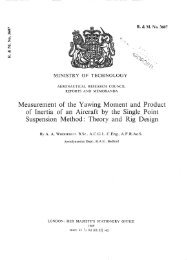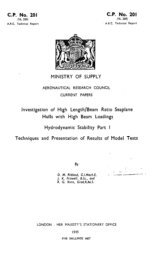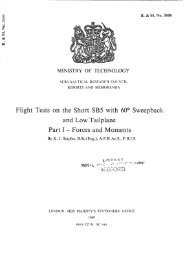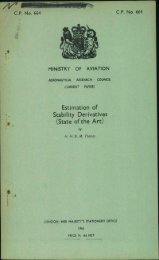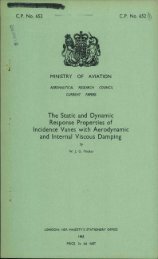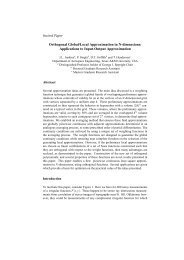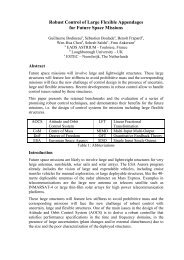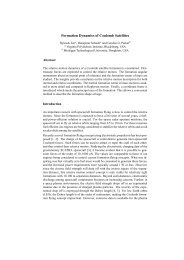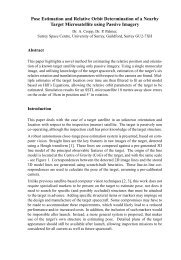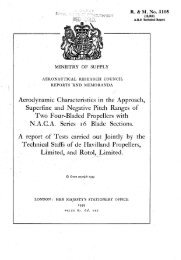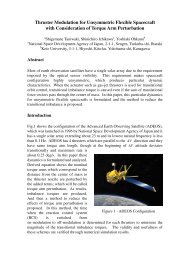A Survey of Unsteady Hypersonic Flow Problems
A Survey of Unsteady Hypersonic Flow Problems
A Survey of Unsteady Hypersonic Flow Problems
You also want an ePaper? Increase the reach of your titles
YUMPU automatically turns print PDFs into web optimized ePapers that Google loves.
- 59 -<br />
The conclusion drawn from Fig. 58 is supported by the results shown<br />
in Wg. 59 for a.geometrically similar cone mth different axis Position and<br />
c.g. position, at M = 2, 3 and 6.83. There is rather more scatter <strong>of</strong> the<br />
experimental points, but there is still .e strong suggestion that the flutter <strong>of</strong><br />
the cone is not greatly affected by Mach number. Calculations by Newtonian<br />
theory and by shock expansion theory were made for the M = 6.83 ease, but only<br />
poor agreement was obtained. The shock expansion result is not shown in Fig. 58.<br />
The failure <strong>of</strong> the analysis using shock expansion theory in Ref. 63<br />
may be related to the fact that the flow is predominantly conical, despite the<br />
unsteady oomponents, and such flows violate a condition for the use <strong>of</strong> shock<br />
expansion theory for three-dimensional bodies.<br />
For the flutter cases in both Figs. 58 and 59 the analysis was found<br />
to be affected by the inclusion <strong>of</strong> e factor from the drag <strong>of</strong> the cone. The<br />
qualitative effect <strong>of</strong> this is shown by one curve in each Figure.<br />
The large variations <strong>of</strong> flutter parameter shown in Fig. 57 for axes<br />
around the mid-length are not shown in Figs. 58 and 59. This may be related<br />
to the particular theory used since the results <strong>of</strong> applying van Karman s theory<br />
in Ref. 63 also showed a dependence <strong>of</strong> critical flutter parameter on Mach number.<br />
But direct comparisons are not possible because <strong>of</strong> the different characteristics<br />
<strong>of</strong> the cones used: the frequency ratio <strong>of</strong> &ma = 0.5, used in the investigations<br />
.for Fig. 57, was not investigated in Ref. 63 and, in fact, Figs. 58 and 59 suggest<br />
that flutter would not have been possible at a frequency ratio <strong>of</strong> O-5 for the<br />
models used in those investigations.<br />
4.2.3 Panel flutter<br />
There appear to be no published results <strong>of</strong> investigations <strong>of</strong> panel<br />
flutter at hypersonic speeds but, since it can be assumed from structural<br />
considerations that displacements will remain very small, the hypersonic<br />
similarity parameter for the displacements, M6, will remain small, and<br />
consequently It is reasonable to draw tentative conclusions about panel flutter<br />
at hypersonic speeds by extrapolation from experiments and piston theory analyses<br />
for lower Mach numbers. This is the basis on which this section has been<br />
written. <strong>Survey</strong>s <strong>of</strong> information on panel flutter at lower M&ch numbers are given<br />
in Refs. 74 and 76.<br />
(i) Flat panels<br />
Analyses for Mach numbers between 2 and 5 indicate that the effects<br />
<strong>of</strong> changes in the fluid dynamics <strong>of</strong> a perfect gas due to increased Mach number<br />
do not cause a significant change in the critical thickness ratio for flutter<br />
This is illustrated by Figs. 60 and 61, from Refs. 69 and 70, for a buckled<br />
two-dimensional panel clamped front and rear, and for B rectangular panel simply<br />
supported on all four edges. These results show, for Mach numbers greater than<br />
about 1.2, a small increase in critical thickoess with increasing Mach number.<br />
But there are two effects occurring in real flight situations which cald make<br />
panel flutter B significant problem at hypersonic speeds. These effects are the<br />
large increases <strong>of</strong> dynamic pressure which can ocour in the local flow conditions<br />
on vehicles, especially on the lifting surfaces <strong>of</strong> vehicles at large angles <strong>of</strong><br />
attack and in intake ducts; and aerodynamic heating effects, which would lower<br />
the elastic stiffness and could set up OODpreSSive stresses in Panels, or even<br />
oause buckling. 'Pyplcal local flow con&Cons which could occur are shown In<br />
Fig. 62 from Ref. 71. The significance <strong>of</strong> the conditions can be gauged from the<br />
critical dynamic Pressure parameter h found by Hedgepeth in Ref. 70:<br />
h/



